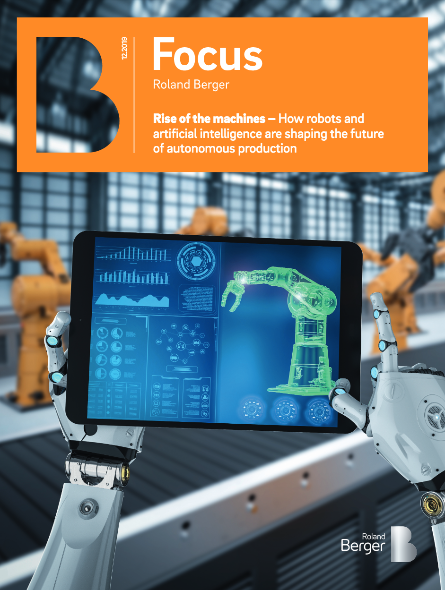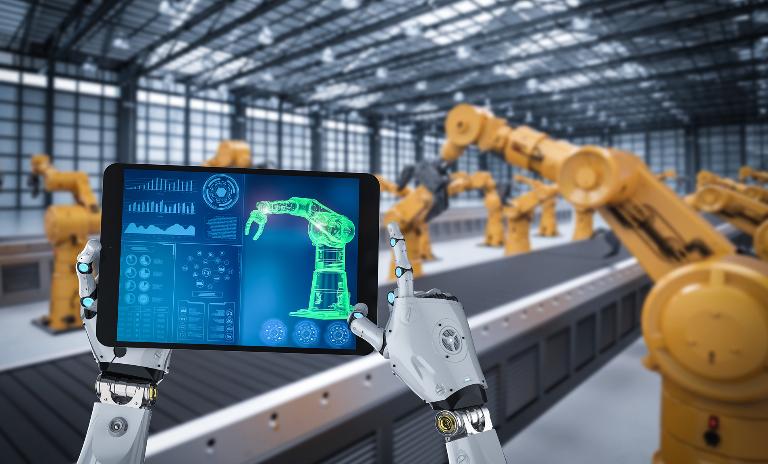Autonomous production: Rise of the machines
![{[downloads[language].preview]}](https://www.rolandberger.com/publications/publication_image/roland_berger_stu_556_cover_download_preview.png)
Manufacturing industries can overcome the barriers of automation production if they employ a few key solutions


Manufacturing industries stand to benefit hugely from automation technologies and Artificial Intelligence (AI) due to increased efficiencies and lowered costs. However, manufacturers still face challenges when it comes to human-robot collaboration, mobile automation and a shortage of IT competencies. These are the key findings of the study “Rise of the Machines – How robots and artificial intelligence are shaping the future of autonomous production” by Roland Berger. The new study discusses industry and task-specific approaches to autonomous production and offers a new way to classify the level of autonomy in production plants, based on interviews with manufacturing CEOs and COOs. It also provides recommendations and solutions to technical and implementation challenges in order to help manufacturers get ahead.
The combination of rising labor costs (25%) and dropping costs of robots (30%) over the last three decades has resulted in a major shift towards autonomous production. Manufacturing industries are trying to utilize automation technology and AI as they move towards the “lights-out factory”, a model in which robots can produce, pack and sort their own products without human intervention. Robot payloads have increased by 2,000% to 2,300kg over the last 30 years, which creates enormous potential for manufacturing industries. Autonomous production is increasing efficiencies, heightening cost-benefit, improving output quality and reducing interdependencies in the workforce. To exemplify the demand for such capabilities, the worldwide market for industrial robots is growing by 10% every year. However, there is a reason why lights out factories have not yet been widely deployed – they present significant technical and implementation challenges.
In order to better understand and recognize these challenges, Roland Berger developed the “Manufacturing Autonomous Level” (MAL) matrix to classify the level of autonomy on a scale of zero to five. The MAL calculates this along the degree of automation (capability of production equipment to perform a defined set of tasks) and the degree of control intelligence (ability to orchestrate several production processes across multiple pieces of equipment). Level zero involves completely manual and human-controlled operations, while level five includes mobile robots autonomously performing complex production and the use of production data to optimize schedules in real time.
Using this matrix, the study found that the semiconductor industry has the highest maturity levels, automotive suppliers are forward-thinking in terms of automation but lag behind in control intelligence and the aerospace industry is still significantly behind. By mapping out different industries on the RB MAL, the study identified key technical challenges facing autonomous manufacturing.
The key technological barriers to autonomous manufacturing involve safe collaboration between humans and machines, mobile automation, adaptive control and picking and identifying unsorted items. In order to overcome these challenges, there needs to be a greater number of joint projects between academia and commercial providers, including startups, universities and private institutes. They need to drive the wider roll out of control parameters with machine learning.
The three main obstacles for implementation of autonomous production were identified as the mix of modern and legacy equipment in production sites, missing competencies in IT – particularly AI – and lack of turnkey providers able to upgrade plants to a certain level of automation. Essentially, the competencies at the technical providers need to match manufacturer’s expertise. To better align these competencies, Roland Berger found that manufacturers need to identify a company’s level of autonomy, create new teams with experts from both manufacturing and IT, roadmap the technologies and use cases, identify partners from industry and academia and implement pilot use cases to build up experience.
Ultimately, it is clear that the autonomous production revolution is well underway. But it is also clear that this transformation has hit technological and implementation barriers. In order to achieve a lights-out factory, manufacturers need to plan and execute solutions now. They must also enlist the help of expert partners to support them on their journey. Roland Berger is ready to provide such expert assistance.

![{[downloads[language].preview]}](https://www.rolandberger.com/publications/publication_image/roland_berger_stu_556_cover_download_preview.png)
Manufacturing industries can overcome the barriers of automation production if they employ a few key solutions
